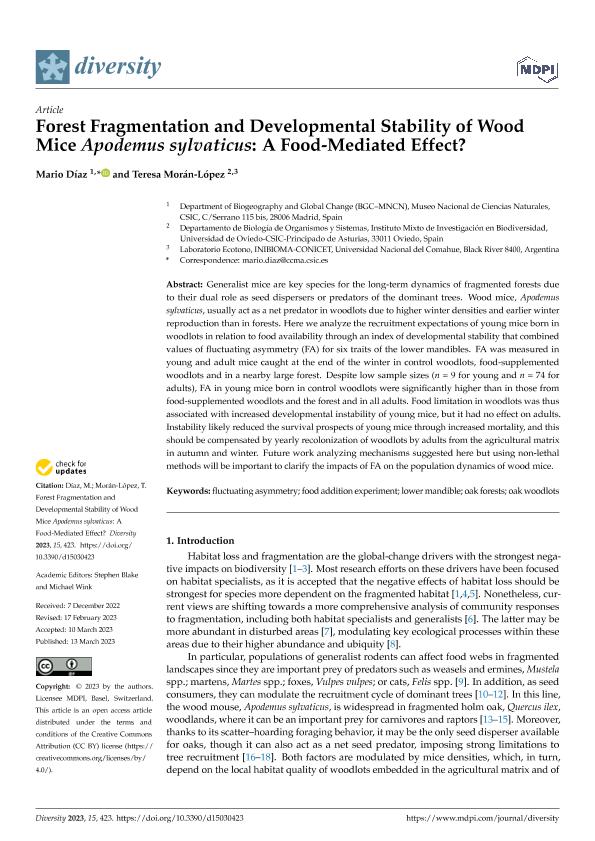Artículo
Forest Fragmentation and Developmental Stability of Wood Mice Apodemus sylvaticus: A Food-Mediated Effect?
Fecha de publicación:
03/2023
Editorial:
MDPI
Revista:
Diversity
ISSN:
1424-2818
Idioma:
Inglés
Tipo de recurso:
Artículo publicado
Clasificación temática:
Resumen
Generalist mice are key species for the long-term dynamics of fragmented forests due to their dual role as seed dispersers or predators of the dominant trees. Wood mice, Apodemus sylvaticus, usually act as a net predator in woodlots due to higher winter densities and earlier winter reproduction than in forests. Here we analyze the recruitment expectations of young mice born in woodlots in relation to food availability through an index of developmental stability that combined values of fluctuating asymmetry (FA) for six traits of the lower mandibles. FA was measured in young and adult mice caught at the end of the winter in control woodlots, food-supplemented woodlots and in a nearby large forest. Despite low sample sizes (n = 9 for young and n = 74 for adults), FA in young mice born in control woodlots were significantly higher than in those from food-supplemented woodlots and the forest and in all adults. Food limitation in woodlots was thus associated with increased developmental instability of young mice, but it had no effect on adults. Instability likely reduced the survival prospects of young mice through increased mortality, and this should be compensated by yearly recolonization of woodlots by adults from the agricultural matrix in autumn and winter. Future work analyzing mechanisms suggested here but using non-lethal methods will be important to clarify the impacts of FA on the population dynamics of wood mice.
Archivos asociados
Licencia
Identificadores
Colecciones
Articulos(INIBIOMA)
Articulos de INST. DE INVEST.EN BIODIVERSIDAD Y MEDIOAMBIENTE
Articulos de INST. DE INVEST.EN BIODIVERSIDAD Y MEDIOAMBIENTE
Citación
Díaz, Mario; Morán López, Teresa; Forest Fragmentation and Developmental Stability of Wood Mice Apodemus sylvaticus: A Food-Mediated Effect?; MDPI; Diversity; 15; 3; 3-2023; 423-445
Compartir
Altmétricas




